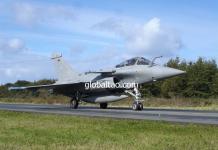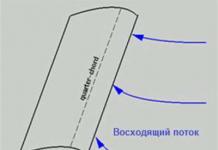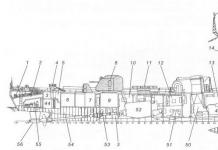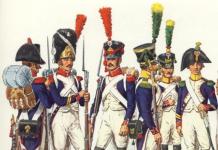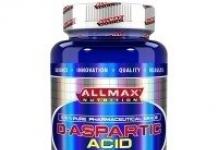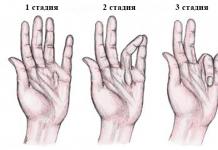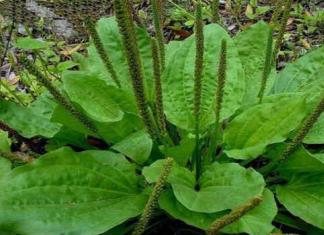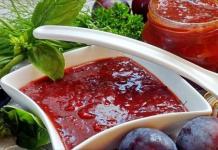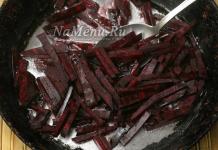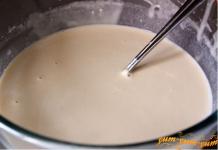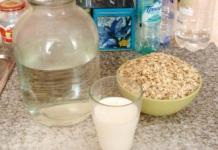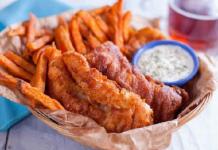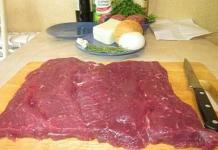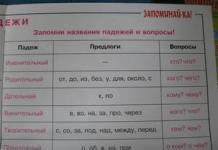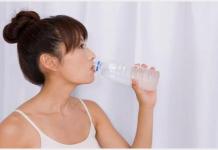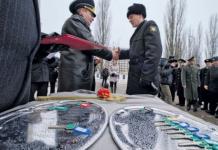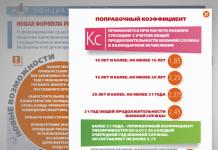MINISTRY OF EDUCATION AND SCIENCE OF THE RUSSIAN FEDERATION
STATE EDUCATIONAL INSTITUTION Academy of Ecology, Marine Biology and Biotechnology Department of Ecology Department of General Ecology Coursework, 3rd year Scientific adviser: k. b. PhD, Associate Professor of the Department of General ecology FENU, I. P. Bezverbnaya LETYAGINA ALENA VASILEVNA Vladivostok INTRODUCTION CHAPTER 1. Literature review 1Microbiological studies of the transfer of alien microorganisms with ship's ballast 2Forms of existence of microorganisms in aquatic microbial communities, methods of their analysis and quantitative accounting 3Preservation and change of pathogenic properties of microorganisms in the aquatic environment CHAPTER 2. Materials and methods CHAPTER 3. Results and discussion BIBLIOGRAPHY INTRODUCTION One of the serious environmental problems is the problem of biological invasion. That is, the introduction of organisms, unusual for this area, into new habitats. One of the ways for microorganisms to enter new water areas is by dropping them with ballast water. Alien organisms can travel across the oceans in the ballast water of ships, adapt to new conditions and, as a result, create significant problems for the marine environment, government property and human health. Outboard water can contain various living creatures - from bacteria and small algae to shellfish, jellyfish and even small fish. These living creatures are taken on board the ship at the port of landing, travel with the ship for many thousands of nautical miles, and are thrown overboard at the port of loading. One of the ways for alien marine organisms to enter port waters is their transportation with ballast water. In particular, this is typical for the ports of the city of Vladivostok. Natural waters can be contaminated with intestinal microorganisms (Vibrio cholerae, typhoid bacilli, paratyphoid, dysentery), leptospira (causative agents of infectious jaundice, water fever), causative agents of tularemia, brucellosis, some viruses (Coxsackie, ECHO, poliomyelitis, trachoma, etc.). It should be noted that under these circumstances, not only infectious agents can be harmful, but also creatures that are quite peaceful in their normal habitat (Sagaydak, 2003). Microorganisms have a unique ability to adapt. They are characterized by high ecological plasticity and the ability to maintain their viability in a wide range of various abiotic factors - humidity, temperature, organic composition, pH, etc. (Bukharin, Litvin, 1997). Due to this, the risk of pollution of port water areas increases. Microorganisms enter into complex relationships with other inhabitants of ecosystems. Hence their ability to produce substances that are called "pathogenicity factors". Controlling the transfer of aquatic organisms with ballast water is a large and difficult task. At present, international regulations have not yet been adopted to control the transfer and introduction of harmful aquatic organisms and pathogens through ships' ballast water. Microorganisms transported with ballast water can be in three forms: in plankton, in sediments and biofilms. It remains a problem to estimate the number and characteristics of these microorganisms. Methods for sampling and microbiological analysis of ballast water have not yet been sufficiently developed. In addition, in Primorye, where several large ports operate, the activities of which are related to the export of goods, the study of the transfer of microorganisms with ship ballast has not yet been carried out. In this regard, it is relevant to conduct exploratory microbiological studies to analyze the situation with the transfer of microorganisms in the ballast tanks of ships and the selection of methods for performing subsequent large-scale monitoring studies. Therefore, the purpose of the course work was: to select methods and conduct a microbiological analysis of ballast water taken on ships operating on the most intensive shipping lines. To achieve this goal, it was necessary to solve the following tasks: ) study existing methods for assessing the abundance and composition of planktonic microbial communities, sediment and biofilm communities in which microorganisms may exist in ships' ballast tanks; ) to analyze the literature data on microbiological studies of samples from ships' ballast tanks; ) to study the known facts and conditions for the manifestation of pathogenic properties by microorganisms isolated from the aquatic environment; ) perform a microbiological analysis of ballast water samples and compile a collection of strains for further research. CHAPTER 1. Literature review 1 Microbiological studies of the transfer of alien microorganisms with ship's ballast The introduction of dangerous marine species with ships' ballast water into new environments has been identified as one of the four biggest threats to the world's oceans. The other three are land-based sources of marine pollution, overexploitation of marine resources, and physical alteration/destruction of marine habitats (AGPS Report No. 4, 1993). Introduced aquatic species have the potential to cause major ecological and economic changes (Carlton et. al., 1990; Mills et. al., 1993) and microbial components may pose a risk to human health (McCarthy and Khambaty, 1994; Hallegraeff, 1998). The main direction in the world transport of alien aquatic species is their transfer with ballast water discharged from ships (Carlton, 1985; Ruiz et. al., 1997). For example, the United States of America is known to receive over 79 million tonnes of ballast water from overseas annually (Carlton et. al., 1995). When ships take on water at one port and discharge at another, the ballast water may include a varying composition of plankton, nekton, and benthos (Carlton and Geller, 1993; Lavoie et. al., 1999). Ballast water research has focused largely on metazoans, but microorganisms are abundant among aquatic organisms. It has been estimated that bacteria and viruses of natural origin in coastal waters have high concentrations (Ducklow and Shiah, 1993; Wommack and Colwell, 2000). Given this specific gravity, high reproductive capacity and wide range of resistance to physical factors, microorganisms are frequent invaders of coastal ecosystems (Ruiz et. al., 2000). Research on microorganisms in ballast water has been limited to date and has focused mainly on Vibrio cholerae (McCarthy and Khambaty, 1994), dinoflagellates (Hallegraeff, 1993, 1998) and protists (Galil and Hulsmann, 1997). An example of the most likely ballast water transport among microorganisms is Vibrio cholerae O1. This species causes cholera in humans. In 1991, Vibrio cholerae was found in oysters and fish intestines in Mobile Bay, Alabama (DePaola et. al., 1992). This species of Vibrio cholerae did not differ from the species responsible for the cholera epidemic in Latin America at the same time. When the ballast water of ships leaving Latin America and arriving at Mobile Bay was tested for cholera, it was found to contain the epidemic-causing species Vibrio cholerae (McCarthy et. al., 1992). This suggests that the ballast water contributed to the introduction of the epidemic-causing species into the coastal waters of the Gulf of the United States. Subsequently, the United States Coast Guard organized the International Maritime Ballast Water Control Organization. Seafarers take steps to reduce the spread of pathogens in ballast water (Federal Register 1991). Currently, the only widely accepted method to control the spread of alien aquatic micro-organisms is open ocean ballast water exchange. This procedure consists in the fact that a ship that has taken ballast water in a coastal port discharges this water into the open ocean and replaces it with ocean water. In turn, this ocean water is released at the next port of call. By reducing the density of coastal organisms, and replacing them with oceanic species, the success rate of microbial invasion is theoretically lower. Differences between ocean water and water at the receiving port where it is released provide a greater chance of ocean species dying (Smith et. al., 1999). However, there are several problems with this exchange procedure; primarily a danger to the ship and crew due to rough seas or due to improper procedure. In addition, many ships only undertake partial exchanges (Carlton, 1995); even when an exchange is undertaken, it is not always fully effective (Zhang and Dickman, 1999), since sediment at the bottom of ships' tanks cannot be completely removed during the exchange (Williams et. al., 1988). Finally, changes in water salinity may affect microorganisms, and especially their dormant stages, slightly or not at all. The volumes of bacterial transfer and the degree of their survival in the new environment can be significant. For example, analysis of the results of microbiological studies of BS and sediments of 69 ships arriving in the Chesapeake Bay (USA) and extrapolation of experimental data showed that up to 1018-1019 bacterial cells transferred with ballast survive in the bay annually (Drake et. al., 2007). The detection and high survival rate of pathogenic and opportunistic bacteria in samples from the ballast tanks of ships, in particular, enterococci, Listeria monocytogenes, Aeromonas spp., Providencia rettgeri, Salmonella spp., Escherichia coli and other representatives of the fam. Enterobacteriaceae, Mycobacterium spp., Clostridium perfingens, Pseudomonas aeruginosa, Pseudomonas putrefaciens, Vibrio algynolyticus, Vibrio cholerae, Vibrio spp. (Burholder et. al., 2007; Dobbs et. al. 2003; Drake et. al., 2003; Ivanov, 2006; Knight et. al., 1999; Whitby et. al., 1998). Thomson et al. showed a high level of antibiotic resistance among pathogenic bacteria found in BV and the danger of these features of introduced bacteria for the communities of the Chesapeake Bay (USA) (Thomson et. al., 2003). Currently, there is not so much information about ballast water microorganisms; universal methods of analysis and quantitative accounting have not been developed. It is known that microorganisms can survive in ballast tanks in water, in sediments and as biofilms. Each of these types of communities is specific, each has its own methods and features of research. 1.2 Forms of existence of microorganisms in aquatic microbial communities, methods of their analysis and quantitative accounting microorganism aquatic pathogen transfer Microbial communities in water can be in various forms. They can be in planktonic form, in the form of biofilms or in sediments. Biofilms. Microorganisms prefer to live attached to a solid surface rather than free-floating - both in the aquatic environment and in the air. They are organized into so-called biofilms (Biofilm), balanced in species composition and functional distribution of community members. Microorganisms in a biofilm exist and behave differently from free-floating bacteria. This is an interacting community of different types of microorganisms that are grouped into microcolonies surrounded by a protective matrix. The matrix is permeated with channels through which nutrients, waste products, enzymes, metabolites and oxygen circulate. All microcolonies have their own microenvironments, differing in pH levels, nutrient uptake, and oxygen concentrations. Bacteria in a biofilm communicate with each other through chemical stimuli (signals). Microorganisms in biofilm are more resistant to antibiotics, antimicrobials and other active agents. In a biofilm, in a different way, in comparison with pure cultures of bacteria, their numerous physiological processes occur, including the production of metabolites and biologically active substances. The community organizes a single genetic system in the form of plasmids - circular DNA that carry the behavioral code for members of the biofilm, determining their food (trophic), energy and other connections between themselves and the outside world. The response of microorganisms to changing environmental conditions in a biofilm is significantly different from the response of each individual species in a monoculture. Such an organization ensures its physiological and functional stability and, therefore, is the key to competitive survival in the ecological niche. Microorganisms in bottom sediments. The most important of the ecological zones is the water space or film on the surface of bottom sediments, where the mass development of phototrophic communities occurs and the primary production of organic matter takes place. The production of organic matter as a result of photosynthesis is a necessary condition for ensuring life in a reservoir. The end products of photosynthesis usually have a large molecular weight. This group of substances includes carbohydrates, peptides, cellulose, soluble and volatile substances - direct substrates for the growth of microorganisms, as well as a number of substances inhibitors or growth stimulants. Sediments are characterized by the presence of forms capable of gliding or attached to the substrate. These include many cyanobacteria, diatoms, green phototrophic filamentous bacteria, flexibacteria, filamentous sulfur bacteria (Netrusov A.I., Bonch-Osmolovskaya E.A. et al., 2004). In ballast water, microorganisms can be found in bottom sediments. Microorganisms in plankton film. The surface film of water is characterized by an abundance of nutrients, mainly lipids, which, due to high surface tension, accumulate here from the water mass and from the air. The surface film is an analogue of a solid substrate, to which microorganisms are attached in mass quantities. The photosynthesis of picoplankton plays a significant role in the creation of the primary production of the World Ocean. It is characterized by some types of cyanobacteria, photosynthetic green sulfur bacteria. Methods of quantitative accounting of microorganisms. The growth of microorganisms in natural substrates or in nutrient media is judged by the change in the number of their cells or biomass per unit volume. Methods for determining these indicators can be direct (counting cells under a microscope, weighing) or indirect. Indirect methods are based on the measurement of parameters, the value of which depends on the number or biomass of microorganisms (the number of colonies that have grown after sowing a cell suspension on a nutrient medium, scattering or absorption of light by a suspension, its protein content, etc.). The choice of method depends on the objectives of the study, the properties of the nutrient medium or substrate, as well as the characteristics of the growth and morphology of microorganisms. Most microorganisms growing in natural samples are still waiting for their turn to be isolated in pure cultures. By some estimates, less than 0.1% of the total microbial diversity can be cultivated. Tens of thousands of species of microorganisms need to be isolated and identified. Although many of these microorganisms are so-called "non-culturable" and thus remain inaccessible to classical microbiological identification methods, there are several ways to assess their diversity and distribution. Cultivated microorganisms have the ability to grow on solid and liquid nutrient media (Netrusov A.I., Egorova M.A. et al., 2005); and uncultivated - organisms that do not germinate on media usually suitable for them. This category refers to the physiological state of known organisms, and not to organisms for which cultivation methods have not been selected (Zavarzin G.A., Kolotilova N.N., 2001). Therefore, the following methods of quantitative accounting for non-cultivated forms are distinguished: Determining the number of microbial cells under a microscope. The method allows to determine the total number of cells per unit volume (both living and dead). The main limitation of the method is the need for rather high concentrations of cells per unit of the studied substrate. 1. Cell counting in counting chambers. This method is recommended for enumeration of some relatively large bacteria. 2. Capillary method of direct counting of microorganisms. Allows you to count small microorganisms. Used for counting microbial cells and monitoring bacterial growth. Cell count on fixed stained smears (Winogradsky-Bride method). This method is used in various modifications to determine the number of microorganisms in a variety of natural substrates. The method also has the advantage that the fixed stained preparations can be stored for a long time. Cell count on membrane filters. This method is recommended for determining the number of microorganisms in substrates with low cell density. Fluorescent microscopy is widely used in the detection and quantitative accounting of microorganisms. Luminescence microscopy also makes it possible to identify and evaluate the number of individual groups of microorganisms in the test sample (Netrusov A.I., Egorova M.A. et al., 2005). Quantification methods for cultivated forms: Determination of the number of cells of microorganisms by inoculation on nutrient media. Unlike counting microorganisms under a microscope, this method makes it possible to determine only the number of viable cells in a population. Since there are no media suitable for the growth of all microorganisms, the seeding method makes it possible to determine only the number of microorganisms capable of growing on a medium of a given composition, and it does not allow taking into account those microorganisms that do not grow (for example, the so-called viable, but not cultivated forms) or grow very slowly. 1.
Determination of the number of cells seeded on dense nutrient media (Koch's method). The method is widely used to determine the number of viable cells in various natural substrates and in laboratory cultures. It is based on the Koch principle, according to which each colony is the offspring of one cell. 2.
Determination of the number of cells by inoculation in liquid media (method of limiting dilutions). The method is used to count microorganisms that grow poorly or not at all on dense nutrient media. Determination of biomass by weighing. This method is widely used to assess the growth of microorganisms in liquid nutrient media. It can also be used to determine the mass of cells grown on solid nutrient medium. Determination of the number of cells and biomass by the nephelometric method. Allows you to quickly and fairly accurately determine the concentration of cells in a suspension or culture fluid. The nephelometric method is suitable only for those microorganisms whose growth causes uniform turbidity of the medium and is not accompanied by a noticeable change in the shape and size of cells, the formation of mycelium, films or other accumulations (Netrusov A.I., Egorova M.A. et al., 2005). .Community structure based on lipid analysis. The information obtained by lipid analysis allows partial penetration into the microbial community. FA samples from natural microbial communities generally represent a wide range of complex molecules in which these FA samples provide quantitative analysis, but interpretation of individual specific community components can be difficult. Quantitative comparisons of total FA samples can provide information about the structure of the community as a whole, but cannot provide a more detailed analysis at the level (within) of individual specific microbial groups. Lipid analysis can be extremely useful when the underlying physical parameters or ecology of the system are known. In particular, LC analysis provides an assessment of sample heterogeneity or heterogeneity within a sample and an assessment of community structure. Lipid analysis provides such information about communities that cannot be obtained by other methods. .Community structure based on nucleic acid analysis. DNA analysis in the samples has been used successfully to enhance the LC analysis. This approach makes it possible to determine the physiological potential of the microbial community. Compared to FA analysis, this is a more detailed approach for studying the structure of microbial communities, it is a combination of the following methods: amplification by PCR, followed by denaturing gradient gel electrophoresis (DGGE) or temperature gradient gel electrophoresis (TGGE) - analysis of rRNA genes. The combination of FA analysis and NC analysis can be very useful for characterizing biomass and microbial community structure. Lipid analysis is an indicator of the phenotypic properties of the community, which show the current microbiological activity, growth rate, action of toxicants, unbalanced growth, deficiency of certain nutrients, metabolic balance between aerobes and anaerobes, while NK analysis allows a more detailed assessment of the structure and physiological potential of the microbial community. 3.BIOLOG. An automated microorganism identification system based on aerobic metabolic activity is used to determine the comparative structure of microbial communities. The system is based on the assessment of differential bacterial metabolic activity against 92 carbonaceous substrates and can show differences in the metabolism of microbial communities. Community structure based on the analysis of isolated strains. To identify cultivated microorganisms, analysis of the content of distinctive ester-linked FA (mainly for phospholipids and lipopolysaccharides of clinical isolates) is currently widely used. Samples of unique (outstanding FAs) from microorganisms grown on standard media are used to differentiate over 2,000 organisms using the standard MIDI Identification System (MIDI, Newark, Del.). Use of this system requires prior isolation and culture of strains. , which make up a significant part of the microbial community, cannot be identified (Hurst, 2002). Many pathogenic and opportunistic microorganisms, remaining in ballast water both in cultivated and non-cultivated states, can pose a threat to aquatic communities in water areas where ballast is discharged. 1.3 Preservation and change of pathogenic properties of microorganisms in the aquatic environment Here are some facts about the transfer of opportunistic and pathogenic microorganisms with ballast water. The bacteriological quality of ballast water of ships coming from foreign ports to the ports of Singapore was studied. As a result, due to the uncontrolled discharge of ballast water and sediment from ships, the threat of the introduction of dangerous pathogenic microorganisms was declared. Ballast water samples from ships in Singapore Harbor were compared for concentrations of bacteria such as enterobacteria, Vibrio spp. and Escherichia coli. The concentration of facultative anaerobic bacteria, which are often agents of disease, in ships' ballast water was higher than in seawater. Ballast water samples gave the following results: 0.7 - 39.5% eubacteria; 0 - 2.5% enterobacteria; 0.2 - 35.8% Vibrio spp.; 0 - 2.5% E. coli. A significant percentage of Vibrio spp. in some ballast water samples increases the risk of pathogen invasion of coastal areas. Fecal contamination of water has also been shown. Due to the content of pathogenic microorganisms in the ballast water, they were regularly monitored. There are also known cases of discharge of ballast water containing pathogenic microorganisms in the harbor of Mumbai (India). According to microbiological analysis of the samples, pathogenic bacteria such as Escherichia coli Shigella-Alkaligens of the Dispar group were abundant compared to other parts of Mumbai harbor where no water discharges occurred. Even Vibrio cholerae, V. parahaemolyticus, Salmonella spp., campylobacters and aeromonads were present in large numbers. There are also a number of cases of transfer of pathogenic microorganisms with ballast water. Which are able not only to survive in new conditions, but also to transfer their genes to other microorganisms. Many viruses have the ability to mutate and therefore constantly form new epidemic and epizootic variants. Viruses and bacteria have the ability to transfer sections of genes from one organism to another. This phenomenon is called horizontal gene transfer. In bacteria, gene transfer by plasmids passing from one bacterial cell to another serves as a recombination mechanism. Through this mechanism, properties beneficial to the bacterial population, such as resistance to antibiotics, very quickly become public domain. Three variants of transfers are possible: 1) Acquisition of a new gene for which there is no homologue in its own genome and in the genomes of phylogenetically related organisms. In this case, a fundamentally new quality arises; 2) Acquisition of a paralogous (structurally similar) gene with a genetically distant relationship. As a result of this transfer, the functional diversity of proteins in the cell increases; 3) Acquisition of a new xenologist gene, functionally replacing its own gene, which, as a rule, is eliminated in this case. The new and old genes are structurally different from each other, but provide similar physiological functions. As a result of horizontal transfer, the body can receive the following benefits: ) A new pathway of biosynthesis or catabolism that provides the body with benefits under changed conditions; for example, the emergence of the ability to utilize a new substrate. ) Increasing resistance to antibiotics, toxins, pathogens that inhibit the growth of cells of this type; through horizontal transfer, genes responsible for the means of "attack", characteristic, for example, of pathogenic microorganisms, can also be obtained. ) Replacement of pre-existing genes with those genes, the products of which increase the efficiency of the functioning of cellular systems: for example, an increase in thermal stability, resistance to inhibitors, optimization of the kinetic characteristics of the protein, integration into complex complexes, etc. ) Acquired genes may also be functionally neutral, duplicating existing genes; such additional genes are insurance for the organism in cases where its own gene is damaged by a mutation or "silenced" due to a violation in the regulatory systems. The acquisition of "foreign" genes can change the direction of evolution of a species, significantly affect the phenotype of an organism, its ability to adapt in the ecological community. A new gene can give rise to a new subpopulation that can displace a preexisting species. Horizontal gene transfer accelerates the evolutionary process compared to gradual accumulation of mutations or intragenomic rearrangements. Of course, this does not negate the selective significance of mutational loss of some function and the important evolutionary role of mutations in genes that control genome stability (systems of replication, repair, DNA modification, etc.) and the mechanisms of regulation and coordination of gene action. Since genes are complex structures and contain different domains responsible for different functions in a protein product, it is obvious that not only whole genes or blocks of genes, but also gene fragments containing individual domains can be transferred through horizontal transfer. Microorganisms introduced into coastal waters enter into complex relationships with other inhabitants of the ecosystems that contain their reservoirs (competition, symbiosis, the “predator-prey” relationship). Hence their ability to produce "pathogenicity factors". Each of them is responsible for the manifestation of specific properties of the microorganism in the infectious process. These include: adhesion and colonization factors - with their help, bacteria recognize receptors on cell membranes, attach to them and colonize cells (various surface structures of the cell wall); invasion factors - thanks to them, the bacterium penetrates the cell (proteins of the outer membrane); factors that prevent phagocytosis - either mask the bacterium from phagocytosis (capsule), or suppress phagocytosis (various proteins - protein A in staphylococci, protein M in streptococci); factors that suppress phagocytosis - substances that suppress the oxidative burst of phagocytes (for example, V-W antigens of Y. pestis); enzymes of "protection and aggression" of bacteria - contribute to the spread of bacteria through the tissues of the host (hyaluronidase, lecithinase, proteases, etc.); endotoxins - are present only in gram-negative microorganisms (liposaccharides and associated cell wall proteins). They are released into the body's environment after cell death and have a diverse inflammatory and pyrogenic effect of a non-specific nature; exotoxins are toxic molecules actively secreted into the environment with the help of special secreted systems (Korotyaev A.I., Babichev S.A., 1998). Thus, microorganisms are able to acquire new genes, move from opportunistic to pathogenic, be resistant to antibiotics, and thus pose a threat to both aquatic communities and humans. CHAPTER 2. Materials and methods Microbiological analysis of water samples is carried out using the Koch plate method. For a detailed assessment of the danger of transported ballast, methods of direct counting of microorganisms using epifluorescent staining with DAPI reagent (2,4,6-diamidino-, 2-phenylindole), analysis of the structure of communities using a spectrum of utilized hydrocarbon substrates (BIOLOG method) and assessment of pathogenicity factors are used in parallel. in isolated strains. Fluorescent methods for the general counting of bacteria. Here, a dye is used that fluoresces, specifically binding to the corresponding components of the cell. These are nucleic acids or proteins, regardless of whether the cell is metabolically active or not. This dye includes 4,6-diamidino-2-phenylindole (4,6-diamino-2-phenylindole, DAPI). This dye binds to DNA and RNA. It is specific and chemically binds to the double strand of DNA, especially to regions rich in adenine and thymine, and to a lesser extent to non-cellular structures. DAPI, as a cationic dye, is adsorbed by negatively charged particles of soil, clay, and phospholipids. It is most suitable for staining microorganisms in aqueous samples. CHAPTER 3. Results and discussion Bacteriological analysis of BS samples from the timber carrier Timber Star, taken in the village of Sakata (Japan), showed that, based on the total number of CFU of heterotrophic bacteria, varying in the range of 103-104 cells/ml (Table 1), the waters are characterized as moderately polluted (Hydrochemical parameters…, 2007). For comparison, similar data for waters b. Golden Horn in August-September 2007 amounted to 106 - 107 cells / ml, which characterizes the waters as dirty (Hydrochemical indicators ..., 2007). Table 1 The number of CFU of heterotrophic bacteria, cells/ml, in water samples from the ballast tanks of the Timber Star timber carrier Date (time spent in the ballast tank, days) September 1, 2007 (10) September 14, 2007 (23) Heterotrophic bacteria (4.2±0.3)×103(3.8±0.5)×103 In the period from 01.09.2007 to 14.09.2007 the vessel did not change the ballast. This made it possible to analyze the effect of BS storage time on the number of bacteria. It was noted that there was no significant change in the number of CFU of heterotrophic bacteria during the 13-day period of BS storage (Table 1). The data obtained are in good agreement with the known data that the duration of ballast storage from 2 to 176 days does not significantly affect the change in the abundance of bacterioplankton (Burkholder et. al., 2007; Hess-Nilsen et. al., 2001). Although there is information in the literature that the concentration of bacteria in BW over a 15-day period can decrease by more than 2 times (Drake et. al., 2003). We found that during the storage of ballast, the morphological diversity of microorganisms decreased. In culture, 28 morphologically different strains were isolated from the 1st sample (1.09.2007). In the 2nd sample (13 days of BV storage), only 12 morphologically different colonies were noted. The studies by Drake et al. (Drake et. al., 2003) also indicate a significant decrease in the diversity of bacteria during storage of BV. In general, Gram-negative motile rod-shaped bacteria with an oxidative type of metabolism dominated in BV samples from the village of Sakata (Japan) (Table 2). For comparison, among the strains isolated from b. Golden Horn, rod-shaped gram-negative forms of bacteria also predominate, but with an enzymatic type of metabolism (up to 65% of the total), which is associated with significant pollution by sewage and insufficient saturation of the waters of the bay with oxygen (Kalitina et al., 2006). table 2 Some morphological and physiological-biochemical features of strains isolated from the ballast water of the Timber Star vessel Cell morphology Rods - 90% Cocci - 10% Motility Motile - 85% Immobile - 15% Type of cell wall (Gram stain) Gram-positive - 28% Gram-negative - 72% Type of metabolism Oxidative - 76% Enzymatic - 15% Do not use glucose - 9 % The results of bacteriological analysis of water samples taken from the ballast tanks of the Minotaur tanker during October-December 2007 showed that the average number of CFU of heterotrophic bacteria varied in the range of 2.5 103-4.1 104 cells/ml (Table 3), which characterizes the samples as moderately polluted or polluted (Hydrochemical parameters…, 2007). These indicators correspond, and in November-December even exceed the average content of colony-forming heterotrophic bacteria in the waters of the Amur Bay. For comparison, the number of heterotrophic CFU at the monitoring station in the area of the First River, where the tanker discharges BW, varied in the range of 1.8 104-9.2 102 cells/ml in the period October-November 2007. Table 3 Number of CFU of heterotrophic bacteria Thus, the microbiological analysis of water samples carried out using the Koch plate method showed that the number of CFU of heterotrophic bacteria in the BW of ships that arrived from the ports of Japan and China in September-December 2007 characterizes these waters as moderately polluted or polluted. In most cases, there was no significant difference in CFU abundance between seawater at the ballast discharge site and ballast water samples. In the sediments of ballast tanks, the number of CFU is 2 orders of magnitude higher than in water. Obviously, a detailed assessment of the danger of the transported ballast requires the parallel use of the method of direct counting of microorganisms using epifluorescent staining with the DAPI reagent (2,4,6-diamidino-, 2-phenylindole), analysis of the structure of communities using the spectrum of recyclable hydrocarbon substrates (BIOLOG method) and evaluation of pathogenicity factors in isolated strains. In the course of the research, a methodology was also developed for taking and analyzing samples from ships' ballast tanks. CONCLUSIONS 1.There are various methods for assessing the abundance and composition of microbial communities. One of the main methods remains the Koch cup method. Direct enumeration of microorganisms is performed using epifluorescent staining. .Literature data have shown that the volume of transfer of bacteria and the degree of their survival in the new environment can be significant. Up to 1018-1019 bacterial cells transferred with ballast can survive annually. Microorganisms are characterized by a unique ability to adapt to new conditions, to move from conditionally pathogenic to pathogenic. .Microorganisms are able not only to maintain pathogenic properties in new conditions, but also to change them. Pathogens can "acquire" new resistance genes. .Samples of BW from the Timber Star timber carrier, taken in the village of Sakata (Japan), characterize the waters as moderately polluted. Dominants - gram-negative motile rod-shaped bacteria with an oxidative type of metabolism. Bacteriological analysis of water samples from the Minotaur tanker characterized the samples as moderately polluted or polluted. In most cases, there was no significant difference in CFU abundance between seawater at the ballast discharge site and ballast water samples. BIBLIOGRAPHY 1.Hydrochemical indicators of the state of the environment / Ed. T. V. Guseva. - M.: Forum: INFRA-M. 2007. - 192 p. .Zavarzin G. A., Kolotilova N. N. Introduction to natural microbiology: Textbook. - M .: Book house "University", 2001. - S. 71 - 73. .Kalitina E. G., Bezverbnaya I. P., Buzoleva L. S. Dynamics of the number of hydrolytically active microflora in conditions of complex pollution of the Golden Horn Bay // Electronic journal "Investigated in Russia". 2006. No. 6. C. 56-66. #"justify">. International Convention for the Control and Management of Ships' Ballast Water and Sediments, 2004. Rule D-2. .Methods of general bacteriology. T.1 / Ed. F. Gerhardt and others - .Netrusov A. N. Ecology of microorganisms: Proc. for stud. universities / A. N. Netrusov, E. A. Bonch - Osmolovskaya, V. M. Gorlenko and others; Ed. A. I. Netrusova. - M.: Publishing Center "Academy", 2004. - S. 65 - 71. 8.Burkholder, J.M., Hallegraeff, G.M., Melia, G., Cohen, A. et. al. Phytoplankton and bacterial assemblages in ballast water of U.S. military ships as a function of port of origin, voyage time, and ocean exchange practices // 2007. Harmful Algae. Vol. 6. Is. 4. P. 486-518 .Dobbs F.C., Diallo A.A., Doblin M.A., Drake L.A. et. al. Pathogens in Ships Ballast Water and Sediment Residuals // Proceedings of the Third International Conference on Marine Bioinvasions. La Jolla. California. March 16-19. 2003. P. 29. .Drake L.A., Baier R.E., Dobbs F.C., Doblin M.A. et al. Potential Invasion of Microorganisms and Pathogens Via Interior Hull Fouling : Biofilms Inside Ballast-Water Tanks // Proceedings of the Third International Conference on Marine Bioinvasions. La Jolla. California. March 16-19. 2003. P. 35. .Drake, L.A., Doblin, M.A., Dobbs, F.C. Potential microbial bioinvasions via ships" ballast water, sediment, and biofilm // Marine Pollution Bulletin. Vol. 55. Is. 7-9. 2007. P. 333-341. .Hess-Nilsen O.K., Jelmert A., Enger I. Effects on the Microbial Community from Ballast Water Discharge at the Norwegian West Coast, Austevoll Aquaculture Research Station // Proceedings of the Second International Conference on Marine Bioinvasions. New Orleans. La. April 9-11. 2001. P. 69-70. .Ivanov, V. Bacteriological monitoring of ships "ballast water in Singapore and its potential importance for the management of coastal ecosystems / / WIT Transactions on Biomedicine and Health. 2006. Vol. 10. P. 59-63 .Knight I. T., Wells C. S., Wiggins B., Russell H. et al. Detection and enumeration of fecal indicators and pathogens in the ballast water of transoceanic cargo vessels entering the Great Lakes // Proceedings of the General Meeting of the ASM. Chicago. IL. 1999. P. 546. .Manual of environmental microbiology / ed. Christon J. Hurst. Washington: ASM Press, 2002. pp. 35-167. .McCarthy, S.A., Khambaty, F.M. International dissemination of epidemic Vibrio cholerae by cargo ship ballast and other nonpotable waters // Applied and Environmental Microbiology. Vol. 60, Is. 7, 1994. P. 2597-2601. .Thomson, F.K., Heinemann S.A., Dobbs F.C. Patterns of Antibiotic Resistance in Cholera Bacteria Isolated From Ships Ballast Water // Proceedings of the Third International Conference on Marine Bioinvasions. La Jolla. California. March 16-19. 2003. P. 118. .Whitby G., Elliot I., Lewis P., Shafer M., Christopher J. A Microbiological chemical and physical survey of ballast water on ships on the Great Lakes 1998 // Abstracts from the 8th International Zebra Mussel and Other Nuisance Species conference. Sacramento. California. March 16-19. 1998. P. 14. 19.Youchimizu M., Kimura T. Study of intestinal microflora of Salmonids // Fish. Pathol. 1976. V. 10. No. 2. P. 243.
HIGHER PROFESSIONAL EDUCATION
FAR EASTERN STATE UNIVERSITY
in samples of water and sediments from the ballast tanks of the Minotaur tanker
Date (time spent in the ballast tank, days / sampling port BV, China) 3.10.07 (2 / Laizhou) 12.11.07 (6 / Laizhou) 23.11.07 (4 / Lanshan) 19.12.07 ( 6 / n. Laijou /) (water / precipitation*) waterHeterotrophic bacteria (cells/ml) (2.5 ± 0.3)×103(7.9 ± 0.5)×103(4.1 ± 0.2)×104(1.8 ± 0.3)×104 ___________ (1.3±0.2)×106 Note: * - the number of CFU of microorganisms is determined in 1 cm3 of precipitation
M.: Mir, 1983. - 536 p.
.Netrusov A. N. Workshop on microbiology: Textbook for students. higher textbook establishments / A. N. Netrusov, M. A. Egorova, L. M. Zakharchuk and others; Edited by A. N. Netrusov. - M.: Publishing Center "Academy", 2005. - S. 101 - 155.
The company "Norta MIT" is a representative of the company Headway Technology Co.Ltd, manufacturer of control systems and ballast water treatment.
INTERNATIONAL CONVENTION FOR THE CONTROL AND MANAGEMENT OF SHIPS' BALLAST WATER AND SEDIMENTS, 2004 The IMO was created as a result of growing evidence of damage from the introduction of alien aquatic organisms, and although its development has taken many years, its ratification is nearing.
This agreement represents a dramatic change in the management of ships' ballast water, and while well-intentioned, there is great potential for disputes, ship delays, cancellation of charter agreements and local penalties.
On September 8, 2016, Finland acceded to the IMO International Convention for the Control and Management of Ships' Ballast Water and Sediment, 2004. Finland became the 52nd State Party to the Convention. At the same time, the total gross tonnage of the ships of these states amounted to 35.1441%. Thus, the countdown threshold for the entry into force of the Convention has been reached, and the document will enter into force on September 8, 2017.
As of today RS has already carried out the examination of ballast water management systems of 12 companies and issued 84 Type Approval Certificates systems on behalf of the Russian Maritime Administration.
The Register has developed Guidelines for the Application of the International Convention on the Control and Management of Ships' Ballast Water and Sediments. Ships in the RS class that comply with the D-1 standard requirement for safe offshore ballast changing, if the ship carries the Guidelines for the safe offshore ballast water change, are assigned the additional BWM mark in the class symbol. RS recommends that all shipowners evaluate the degree of compliance with the requirements of the Convention on their ships, select an approved ballast water management system and develop appropriate technical documentation
Ballast Water Management System
OceanGuard® Ballast Water Management System
OceanGuard® BWMS developed and provided by Headway Technology Co, Ltd in cooperation with Harbin Engineering University. Its unique structure and optimal design allows the vessels, during the delivery of ballast water, not to pose a threat to marine life in the surrounding waters, thus preserving the marine ecology.
BWMS Installation Diagram

Compliance with the requirements of classification societies
The OceanGuard® Ballast Water Management System has been approved by classification societies such as IMO , Lloyd's Register (LR), ABS, BV , CCS , DNV , NK , RINA , Russian Maritime Register of Shipping (RS), and also evidence Alternate Management System (AMS) released by USCG .
Advanced technology. AEOP Electro-Catalytic Oxidation Process
The hydroxyl radicals generated during the AEOP purification process disappear within a few nanoseconds. These radicals have a high sterilization efficiency, which is able to effectively kill various bacteria, viruses, algae and dormant eggs in ballast water (wide sterilization spectrum) in a chain reaction mode.
The sterilization process can be completed inside the EUT. The concentration of TRO (Total Residual Oxidation) can be adjusted within 2 ppm so that TRO can perform advanced control functions in ballast tanks.
No corrosion
The hydroxyl radicals generated during the cleaning process disappear within a few nanoseconds. The sterilization process is completely completed inside the EUT. At the same time, the concentration of TRO remains within 2 ppm. Based on the results of long-term operation, the system has proved to be safe and reliable, and water treated with BWMS does not cause corrosion of the hull.
Compact design; High quality components
Compact structure, small size, easy installation and maintenance. BWMS can be installed on various ships with various internal structures. High quality materials and components with a long service life are used for all components.
Processing in one pass
The complete cleaning process takes place during the intake of ballast water, there is no need to perform cleaning when issuing ballast water. Suitable for all types of boats.
energy efficiency
Low operating costs. To treat 1000 m3 of ballast water, the electricity consumption is about 17 kWh.
Explosion proof
BWMS has an explosion proof certificate. This allows you to install it in the premises of pumping stations of oil tankers and liquefied gas carriers.
Wide range of applications
BWMS provides excellent performance in both fresh and sea water applications. The treated ballast water produced does not cause any harm to the environment.
BWMS product line
| Name | Rated capacity, m3/h | Productivity, m3/h | power, kWt | Dimensions, mm |
| HMT-100 | 100 | 30-120 | 2 | 370x380x1400 |
| HMT-200 | 200 | 80-250 | 3.5 | 510x380x1400 |
| HMT-300 | 300 | 150-350 | 5 | 510x380x1735 |
| HMT-450 | 450 | 300-550 | 7 | 569x416x1815 |
| HMT-600 | 600 | 350-700 | 10 | 600x470x1900 |
| HMT-800 | 800 | 400-950 | 13.5 | 620x470x1900 |
| HMT-1000 | 1000 | 600-1000 | 17 | 640x570x2100 |
| HMT-1200 | 1200 | 800-1400 | 20 | 730x570x2100 |
| HMT-1500 | 1500 | 1000-1700 | 25 | 730x620x2200 |
| HMT-2000 | 2000 | 1500-2300 | 33.5 | 880x620x2200 |
| HMT-2500 | 2500 | 2000-2800 | 42 | 1030x640x2210 |
| HMT-3000 | 3000 | 2200-3500 | 50 | 1460x620x2200 |
| HMT-6000 | 6000 | 4500-6500 | 100 | 1460x1240x2200 |
| HMT-9000 | 9000 | 6500-10000 | 150 | 2060x1280x2210 |
In this video you can see how the Headway ballast water treatment system works.
AEOP BWMS technology
BWMS developed by the company Headway Technology Co.,Ltd in cooperation with Harbin Engineering University. BWMS uses an advanced Electro-Catalytic Oxidation Process (AEOP) to neutralize microbes, bacteria, viruses and dormant eggs in water using special semiconductor materials by electronic excitation and hydroxyl radicals (-OH) formed by water molecules. Hydroxo groups (-OH) in the AEOP process are one of the most active substances with very strong oxidizing properties. With the help of various types of chemical reactions, they instantly affect all biological macromolecules, microorganisms and other organic pollutants. In addition, they have an extremely fast reaction rate and a strong negative charge. The end products of the reaction are CO2, H2O and traces of an inorganic salt without any hazardous residues. In this way, the treated waters can be dumped overboard without the risk of environmental pollution. The chemical reaction that involves hydroxyl radicals is a free radical reaction, and it is a very fast reaction. Usually the rate of reaction with microorganisms is over 10E9 l/mol*s. In addition, the lifetime of the hydroxo group forms is quite short, less than 10E-12 s, so that the high efficiency of BWMS is guaranteed.
EUT block is the main element of the BWMS system. Each individual block has a capacity of 100 to 3000 m3/h. The block consists of two parts: Electro-catalysis block and Ultrasonic block. The Electro-catalysis unit is capable of producing large amounts of hydroxyl radicals and other highly reactive oxidizing agents to neutralize all organisms in ballast water within a few nanoseconds. In the disinfection process, the ultrasonic unit can regularly clean the surface of the electro-catalysis unit, which ensures the long-term effectiveness of the electro-catalyst material. The complete disinfection process takes place inside the EUT block.
Benefits of the control panel
· Local and remote control;
· The fault can be routed to the ship's control system;
· Siemens LED monitor displays the status of system components in real time;
· Siemens programmable controller monitors sensor readings in real time;
· Storage of parameters in memory within 24 months. The parameters can be printed at any time;
· Simple operation.
BWMS filter performs a fully automatic backwashing of the filter, which can take place simultaneously with filtration and reverse circulation. Filtration accuracy 50 μm. This allows organisms larger than 50 µm to be removed to prevent sedimentation in the tanks.
Filter Benefits
Provides maximum filtration;
· Automatic backwash during filtration;
High performance proven by test results in various waters;
· Robust design easy to operate;
· Low pressure loss, no need to install a booster pump.
The filtration stage is essential in the ballast water treatment process.
As required by the International Convention for the Control and Management of Ships' Ballast Water and Sediment, IMO 2004, both ballast water and sediment are an important component. Thus, through a practical study of sediments, including sediments in ballast tanks, it was determined that sediments in ballast tanks not only provide ground for the development of organisms, but can also lead to serious corrosion of the hull. The following images of deposits and corrosion compare the same ballast tank.


For all of the above equipment, we supply spare parts according to the manufacturer's catalog numbers .
Doom"TorryCanyon”
1967, marked by the rescue of MareNostrum and the sinking of TorryCanyon, was a particularly horrific year. As evidenced by the Lloyd's Register, it turned out to be the most difficult year in the history of shipping - 337 ships with a total displacement of 832.8 thousand tons were lost in various areas of the ocean. Fifteen of them disappeared without a trace and for unknown reasons. Most of the rest owed their deaths to known enemies: water entering the compartments, collision, fire on board, stranding or reef.
The TorryCanyon was one of the ships that hit the underwater rock. The responses of this event are still heard in many countries of the world. In one form or another, it affected the governments of Liberia, England, France and the United States, greatly contributed to human awareness of the danger of environmental pollution and, in the end, should lead to the issuance of laws and regulations that necessitate the development of new rescue methods to prevent surface pollution. seas in the event of an accident of such giant tankers.
Tanker "TorryCanyon" with a length of 296.8 m was one of the largest ships in the world. Its hull, in fact, was a lot of floating oil tanks, to which a superstructure was added as a kind of appendage, and somewhere deep inside two steam turbines with a total capacity of 25,270 liters were hidden. s, the tanker held 850 thousand barrels of oil - 117 thousand tons! The tanker's own fuel tanks were designed for 12.3 thousand tons of liquid fuel. The ship was assigned to Monrovia, the capital of Liberia, but belonged to the Barracuda Tanker Corporation. The company's headquarters were located in Hamilton, Bermuda, where the filing cabinets of Butterfield, Dill & Co. kept documents that practically amounted to all the property and essence of the company. The Barracuda Tanker Corporation was not a subsidiary of the Union Oil concern, although it was a purely holding company of the latter, formed only to lease ships to the concern in order to reduce - on a completely legal basis - the amount of taxes they paid. True, this somewhat complicated the matter when it was required to initiate legal prosecution against someone. The plaintiffs - they were countries, not individuals, at first did not really understand who, in fact, should be sued.
The TorryCanyon had a crew of 36, led by Captain Pastrengo Ruggiati. The ship had a radar with a range of 80 miles, a Loran radio navigation system, a radiotelephone station for talking with the shore, and an echo sounder with a recorder. Insured for 18 million dollars. the tanker was assigned class 100A1 of the Lloyd's Register - the highest class for ships of this type.
On March 18, 1967, the TorryCanyon, returning from the Persian Gulf with a full cargo of oil, approached the Isles of Scilly - 48 bare rocks that protruded from the water at a distance of 21-31 miles from the tip of the Cornwall peninsula in England.
At 8:18 a.m., Rugiati decided to steer the ship into a passage 6.5 miles wide and 60 meters deep between the islands and a granite reef known as the Seven Stones. The British Admiralty Guide to Crossing the English Channel advises captains of large ships not to use this passage. Unfortunately, Ruggiati did not have this useful little book with him.
The English Channel was littered with fishing boats, and Ruggiati could not turn where he should have. At 0848 he realized that the tanker was heading straight for Pollard Rock, 16 miles off the coast of Cornwall. He ordered the helmsman to sharply turn the rudder to the left, but for a reason that remained unexplained, the steering switch was in automatic mode, so it was useless to turn the helm.
It took two minutes to put the switch in the right position and sharply shift the steering wheel to the left; it took only 1 minute and 58 seconds for the tanker to hit Pollard Rock.
Distress signals went on the air, while Ruggiati unsuccessfully tried to get the tanker off the cliff. Seven vessels responded to the calls, but the Utrecht was the first to arrive at the scene of the accident, which belonged to the same Dutch company Weismuller, whose tugboats had recently saved the Mare Nostrum. By the time the Utrecht arrived, the company had already phoned Pacific Coast Transportation in Los Angeles, representing the ship's owners, and were trying to negotiate a contract to salvage the tanker on the usual "No Salvation, No Reward" basis. If such a contract could be concluded, the rescuers would have made at least a million dollars.
At 1240, Hille Post, the captain of the Utrecht, put his men on board the tanker. Near the accident site, two British Navy helicopters hung in the air, ready, if necessary, to remove the crew and rescuers from the TorryCanyon, since by this time the ship, partially flooded, was rolling heavily under the impact of the waves from side to side and hitting the rocks. About 5,000 tons of oil have already spilled into the sea from the ruptured tanks of the tanker. In an attempt to reduce the mass of the ship, the crew actively pumped the rest of the oil overboard, resulting in an oil slick about six miles in diameter around the TorryCanyon. The minesweeper Clarbeston approached the scene of the accident, delivering a thousand gallons of emulsifier (detergent): the tugboat Jayzent was also approaching with the remnants of the Navy's stocks - 3.5 thousand gallons of detergent on board. The next morning, March 18, two more Weissmuller tugs, the Titan and Stentor, arrived, as well as the Portuguese tug Praia da Draga, chartered by the company.
The TorryCanyon engine room was almost two meters flooded with water and oil, the boilers went out, the pumps stopped, only emergency generators worked. as the seawater displaced the oil from the bow tanks, the tanker became completely buoyant at the bow. The edge of the bulwark of the forecastle, tilted by 8°, was already level with the surface of the water, a strong wind was blowing, 16 people asked to be removed from the tanker.
On the same night, after the Utrecht's towline broke during an unsuccessful attempt to pull the TorryCanyon off the rocks, helicopters and the tanker's lifeboats removed all the people who were there. It got only the captain Ruggiati, three members of his crew and two rescuers.
In the 30 hours that have passed since the accident, the oil has spread over the water in a giant strip 18 miles long and 4 miles wide. Along the edges of the strip, she floated on the water with a thin film, but near the tanker, her thickness reached 455 mm.
By order of British Prime Minister Harold Wilson, Morris Foley, Deputy Secretary of Defense (Navy), was appointed head of the rescue operations. The problem that arose was extremely complex, both politically and legally - the ship, the property of citizens of another country, was in international waters, outside the three-mile zone of British territorial waters. Any actions of the government of England, as well as its complete inaction, could seem to someone wrong or illegal.
On March 20, Secretary of Defense Denis Healey announced that 20 ships were using 200,000 gallons of emulsifier (detergent) to the tune of 500,000 lbs. Art. Critics of the government's actions demanded that the tanker, whoever owns it, be burned or, in extreme cases, the oil remaining in its tanks be transferred to other tankers. Those who put forward such a proposal did not understand that pumping would have to be carried out using a vacuum system (energy sources on the TorryCanyon, of course, had long since failed) and this would take several months at best. In addition, such a plan assumed the possibility of creating a reliable hose connection between tankers, which was very doubtful.
On the same day, a specialist in this kind of work, Weissmuller representative Hans Stahl, who took part in the rescue operations, reported that out of 18 TorryCanyon cargo tanks, 14 were torn apart by pitfalls. The rock, like a giant finger, pierced more than 5 m into the bottom of the ship. The tanker's fuel tanks, pump rooms and forward cargo spaces were also pierced.
On Tuesday, March 21, relations between the Union Oil concern and the British government became more tense: oil spread over an area of 100 square miles, with a huge slick moving towards England. It was expected that by the end of the week it would reach the coast of Cornwall - the main seaside resort area of England.
Despite the growing tension, rescue work continued, but on Tuesday at noon there was an explosion in the engine room. Many were injured in the process, and two - Rodriguez Virgilio and Hans Stahl were thrown overboard by the explosion. Thirty-six-year-old Steel, who was lifted from the water after Virgilio remained unharmed, died before he could be taken to a hospital in the English city of Penzance. The cause of the explosion, in all likelihood, was a spark that ignited oil vapors in the space below deck. The Weissmuller Company had already spent $50,000 on salvage work, and for this reason did not intend to abandon the continuation of attempts to salvage the ship at such an early stage of the operation.
By Wednesday, March 22, the water level in the engine room had risen from 1.8 to 16.7 m. ”) so that the tanker floats on an air cushion. Pilots David Eastwood and Thomas Price delivered by helicopter to the deck of TorryCanyon 6-ton compressors taken from rescue boats.
In the meantime, a 14-member scientific and technical committee was urgently formed under the chairmanship of the chief scientific adviser to the British Prime Minister, Solly Zuckerman. The Council was to consider possible actions in the event of the failure of the operation to rescue the tanker. The only way out was to destroy the ship, along with the 80,000 tons of oil still in her cargo tanks. If it is not possible to destroy the tanker, then one should try to deal with the oil directly on the coast. The army, the members of the committee decided, in this case would be responsible for cleaning up the beaches and the 300-meter strip of water along them, and the Navy would clean up the oil from the surface of the water outside this zone.
At the end of the Easter week, March 24-26, the Weissmuller company made a last attempt to save the tanker. This was facilitated by a very high tide - the water level was almost two meters higher than at the time of the Torry Canyon accident. Only one problem remained unresolved: where to tow the ship when it was taken off the rocks. The tanker, even in its current deplorable state, cost at least $10 million. (naturally, only after it is pulled into the water), but not a single country in the world would allow this oil-spewing hulk to be towed into its coastal waters.
Plans to rescue the tanker ended in complete failure. Several times the tugboats “Utrecht”, “Stentor” and “Titan” (the total power of their engines reached almost 7 thousand hp) tried to pull the tanker off the rocks, but, despite the compressors working at full load, supplying compressed air to the cargo the ship's tanks, and the high tide, the TorryCanyon never moved an inch. On Sunday afternoon, a clearly visible crack formed in the hull of the tanker, probably caused by the vessel's hitting stones that had not stopped for 8 days. By noon on March 27, the tanker broke in half, and now both halves of the vessel were separated by 8 m of water. There was still hope to save the stern of the ship, but she slipped off a cliff into the sea and sank.
As early as Friday, storm winds at speeds of over 70 km/h drove oil to the coast of Cornwall, where it flooded the beaches for almost 100 km. The first reports began to appear in the newspapers about the sad fate of seabirds caught in the oil strip.
On March 28, at 9 am, the Weissmuller company decided to stop further attempts. Because the company didn't save anything, it didn't get anything. On the same day, the Union Oil concern renounced its rights to the tanker in favor of insurers - the American ship insurance syndicate and some Lloyd's insurance companies. Almost immediately, British Navy aircraft began bombarding the ship to ignite and destroy the oil before it completely destroyed the beaches. Such action was like shooting cannons at sparrows, but at the same time it was the only way out, since the plan to use explosive charges that could be accurately calculated and laid was rejected as too risky.
Bombers of the English Navy “Bukenir”, approaching the target at a speed of 900 km / h, dropped 41 bombs weighing 450 kg each from a height of 760 m onto the tanker. Aluminum was added to the explosive-incendiary mixture that the bombs were equipped with to increase the flame. The fuses, set with a delay of 0.035 s, were supposed to detonate the bombs after they pierce the deck of the tanker. 30 bombs hit the target.
The bombers were followed by RAF Hunter jet fighters, dropping aluminum tanks of aviation gasoline suspended under their wings into the flames of fire. More than 20 thousand liters. gasoline was supposed to help spread the fire. Thick columns of smoke rose into the sky over the tanker engulfed in flames for two hours. The next day, air raids resumed. Rockets and another 23.5 thousand liters flew into the fire. aviation gasoline. Napalm thrown into the oil floating on the water did not ignite it. On March 30, another 50 tons of bombs hit the tanker. The bombing cost the British government £200,000. Art.
From April 7 to 13, divers from the Plymouth Naval Base, led by Lieutenant Cyril Lafferty, surveyed the remains of a tanker lying at a depth of 20 m to determine how much oil was still left in her tanks. Only in some of them was a layer of semi-hardened oil found. Torry Canyon was dead.
But the epic connected with him was just unfolding. As soon as the bombardment ended, a massive operation began to clear the coast of Cornwall. At the same time, they tried to save seabirds whose feathers were soaked in oil or detergent. Everything turned out to be in vain. The freshly cleaned beaches were again flooded with oil brought by the surf, and the birds - they simply died.
1,000 marines were at the head of the strike force sent to clear the coast, followed by 1,200 British soldiers. People got to hard-to-reach areas by ropes lowered from rocks - and in some cases they, along with supplies of detergent, were lowered from helicopters. There was little sense from the volunteers from among the population, and sometimes they just got in the way. The help of the women's volunteer corps turned out to be more effective. The US Air Force Air Force 3 contributed 86 men, 34 trucks and half a million dollars. 78 British fire brigades were sent in full strength to fight the oil. In the end, the joint efforts paid off. In mid-May, the troops returned to their quarters, and by early June the beaches were cleared of oil. After an understandable lack of people at the beginning of the season, by the end of the summer, the resorts resumed normal activities.
As the results of the operation showed, the use of chemicals was, apparently, the best way to deal with major oil pollution. The trouble in this case was only that there was too much oil. Even before the start of the bombardment of the tanker, about 50 thousand tons of it leaked out; approximately 15 thousand tons of this amount evaporated or dissipated naturally. Thus, 35 thousand tons remained on the sea surface. Approximately 3.5 thousand tons of emulsifier detergents were used during the operation - an amount sufficient to disperse or bind 15 thousand tons of oil. 20 thousand tons of oil were washed ashore.
The disastrous effects of oil pollution
In the course of the events described, a number of other unpleasant facts also came to light.
A perfectly clean-looking beach could be saturated to a considerable depth with oil that had seeped there under the action of the surf. The only way to fight in such cases was to plow and harrow such areas. The most discouraging was that the detergent, effective on oil, turned out to be extremely toxic to marine vegetation and living organisms of the intertidal zone. Shellfish (clems, mussels and oysters) were the hardest hit, with oil and detergent combined being more damaging than either alone.
On the high seas, oil floating on the surface does not harm marine organisms. However, after being treated with detergent, plunging into the water, it brings death to the inhabitants of shallow water, unable to flee.
The heaviest blow fell on the birds. Their oil- and detergent-soaked feathers lost their water-repellent properties and no longer retained heat, which led to a rapid cooling of the body. Lungs, throats, intestines of birds, clogged with foam from oil and detergents, were burned. Oil, in addition, caused peritonitis, disruption of the liver and kidneys, paralysis and blindness. Birds whose feathers were heavily saturated with oil perished without exception; less than 20% of the victims survived. On the coast of Cornwall, 20,000 guillemots and 5,000 auks perished. Nesting area decreased by 25%. Of the 7849 rescued birds, only 450 survived a few days later.
On April 9, a 30 x 5 mile oil slick from the Torry Canyon reached the coast of Brittany. The French government did not have time to take any action while wind-driven oil at a speed of 35 knots approached the coast of France. In order to somehow bind the oil floating on the water, it was sprinkled with sawdust; on the shore it was collected by the local population shod in rubber boots with the help of shovels. The whole operation cost France 3 million dollars.
On April 3, meetings of the commission of inquiry began in Genoa, officially created by the government of Liberia, but actually consisting of three American businessmen. The Commission acknowledged that Captain Rugiati was solely responsible for the sinking of the Torry Canyon. In September 1967, he was stripped of his captain's diploma. Many observers made a big fuss about the allegedly biased decision of the commission, trying to prove that the real culprits are the Barracuda Tanker Corporation or Union Oil. Such a point of view seems somewhat strange, given the gross violations of navigation rules committed by Rugiati and recognized by him on that memorable morning. Even at the dawn of the development of navigation, the responsibility of the captain for his ship became an immutable maritime law. No matter how harsh it may seem, there is no place for democracy on a ship at sea, it is unacceptable. And power inevitably means responsibility.
On May 4, the British government filed a formal lawsuit with the Supreme Court against the Barracuda Tanker Corporation, in which it asserted its rights to the company-owned vessels Lake Palourd and San Sinena, the same type as Torry Canyon. The court brought the case in the absence of the defendant, in this case the Barracuda Tanker Corporation. On July 15, the British caught Lake Palourd when she stopped for one hour in Singapore, and nailed a subpoena to her mast, "arresting" the tanker until the company issued a promissory note in the amount of 8.4 million dollars.
The French were five minutes late in doing the same operation, but then they caught a tanker in Rotterdam and thus forced the company to issue them a similar undertaking.
Onion Oil, which chartered Lake Palourd, as it once did Torry Canyon, filed a US District Court request to limit the amount of debt to a “limited fund,” which in the US is considered equal to the value of the salvaged vessel, property or cargo. Because one of the TorryCanyon life rafts was washed ashore a few days after the disaster, Union Oil and/or Barracuda Tanker Corporation had a debt of only $50.
However, according to the decision of the Court of Appeal, the right to such a limitation of liability was granted only to the owner of the vessel, and not to its charterer. After such a decision was made, Union Oil began negotiations to resolve the conflict. On November 11, 1969, Barracuda Tanker Corporation and Union Oil agreed to pay the British and French governments a total of $7.2 million. in reimbursement of the costs of eliminating the consequences of pollution of the coast of Cornwall and Brittany.
Insurance companies that have already paid out $16.5 million insurance for the lost ship, were forced to fork out again. Lloyd paid about 70% of this amount, the rest was taken over by the American consortium.
The Torry Canyon case will no doubt have far-reaching implications and will have some impact on some aspects of maritime rescue operations.
The 2004 IMO International Convention for the Control and Management of Ballast Water from Ships was created as a result of growing evidence of damage from the introduction of alien aquatic organisms, and although its development has taken many years, its ratification is nearing.
This agreement represents a dramatic change in the management of ships' ballast water, and while well-intentioned, there is great potential for disputes, ship delays, cancellation of charter agreements and local penalties.
There are many documented cases where the invasion of certain marine organisms has affected the local ecology with serious consequences for both the health and well-being of the coastal and inland waters of the region.
The three most notorious cases include the striped mussel in the Great Lakes, the comb jellyfish in the Caspian Sea, and the 1991 cholera outbreak in Peru.
In the marine environment, invasive organisms are found in plankton, eggs and larvae, which are taken on board during ballast water operations. Consequently, they can be transported across the seas and oceans, eventually being dumped into various bioregions, where local natural conditions can cause their death or, in some cases, rapid growth to the detriment of local organisms and the natural environment. 
While 90% of today's world trade passes through , invasive marine organisms are inextricably linked to the 3-5 billion tons of ballast water transported around the world as part of the normal water transport process.
The Convention has developed an answer to the problem of invasive organisms, it has been about 20 years since the introduction of voluntary rules for the control of ballast water in the early 1990s. The convention will enter into force 12 months after it has been ratified by 30 states, representing 35% of world trade tonnage. At the end of May 2011, 28 states, representing 25% of the world's tonnage, had already signed the agreement.
The share in world tonnage is the most important indicator, as there remain several large shipping nations that have not yet ratified the agreement. In order for the convention to enter into force, it remains to wait for the signing of just a few of them. This may happen in the next year, and the convention may well be ratified and enter into force in 2013.
An increasing number of countries and regional authorities are now requiring ships entering their waters to perform a Ballast Water Exchange (BWE) as a condition of obtaining a permit to discharge ballast water in port areas.
While ballast water exchange may become common practice for ships operating in many ports and regions, this measure is considered by the IMO as an interim measure to combat invasive marine organisms and will be replaced .jpg) but according to the plan of the convention.
but according to the plan of the convention.
For most ships over 400 gross tons, the implementation of the principles of the convention will in one way or another require the installation of IMO-approved ballast water treatment systems. These complex and expensive devices are capable of separating and physically destroying plankton and bacteria contained in ballast water right on board the ship, reducing their content to the allowable limits defined in the convention.
Convention rules already require certain ships built in 2009 or later to be equipped with such systems. The intention is to equip all justices of the peace by 2016.
For operators and shipowners, this raises questions such as:
– Which system to choose?
- Where to install it?
– Will the system be able to cope with the requirements of the convention while the vessel is in operation?
System selection
In terms of manufacturer selection, the list of IMO-approved ballast water treatment system suppliers is growing. Many of them use technologies based on land-based water treatment technologies, while others present more innovative solutions, such as the use of inert gases and chemical biocides.
At the moment, quite a few systems have been installed on ships, so it is not yet possible to assess their performance. As a result, ship owners and operators do not yet have much confidence in the various types of systems, and can only hope that the selected ballast water treatment system will prove reliable and efficient in the long term.
Installation
Once a system has been chosen, it is relatively easy to install it on a ship under construction in a shipyard, as designers can schedule the process during the construction phases.
However, it has been estimated that following the ratification of the convention in the coming years, there will be around 50,000 ships and other floating craft that will need to install ballast water treatment systems. The current state of the world's shipyards and factories cannot meet this demand, and shipowners who require installation may find themselves having to wait for an available factory for a long time.
Application
Finally, once the system is in place (perhaps at considerable expense), it may be that major problems are yet to come.
This problem will prove to be the practical effectiveness of the equipment and its ability to ensure full compliance with the requirements of the convention under the close supervision of flag country officers, port authorities and other competent authorities.
In order to be certified by the IMO, a ballast water treatment system must pass a series of tests on land and on board, which have a specific set of environmental criteria. While it may be possible to determine the effectiveness of a system with some accuracy under controlled, almost laboratory conditions during the authorization procedure, the actual operation of the system may be quite different.
While there are specific guidelines for testing methods, there is no specific common protocol that should be used at the port level to determine if the ballast water treatment criteria are in accordance with the convention's ship-defined standards. There is an ongoing discussion on how to achieve maximum compliance of the courts with the requirements of the agreement. These include fundamental questions such as sampling methods and whether sampling should be random or total.
Water ballast- this is water and substances suspended in it, taken on board the vessel to ensure the required trim, roll, draft, and stability of the vessel. According to IMO estimates, about 12 billion tons of ballast water are annually moved as ballast on ships sailing in all regions of the World Ocean.
During the ballast passage, to ensure the safety of navigation, tankers take sea water as ballast into oil-free "dirty" cargo tanks. Clean tanks are filled with sea water directly, without their preliminary preparation. Before filling "dirty" cargo tanks with sea water, they must be cleaned from the NV present in them in accordance with the established procedure.
The available research results show that in the ballast water and sediment carried by ships, even after voyages of several weeks, many species of bacteria, plants and living organisms can survive and persist in a stable form. The discharge of contaminated ballast or sediment into the waters of a port State may introduce undesirable species of pathogenic organisms into these waters, disturbing the ecological balance, damage recreational areas, endanger the health and life of the local population, animals and plants. The occurrence of diseases can also be the result of large quantities of ballast water (BW) containing viruses or bacteria entering the waters of the port State.
The most common types of microorganisms (defined as pathogenic or opportunistic pathogens) are Escherichia coli, Staphylococcus aureus, and Salmonella. At times, the presence of intestinal bacilli is observed. The IMO estimates that 4,500 different species are transported around the world at one time in ballast tanks. Therefore, the discharge of BV is considered potentially dangerous not only by the IMO, but also by the WHO, which is concerned about preventing the spread of pathogenic epidemiological bacteria with BV.
The ballast is water taken directly from overboard. Together with water, pumps pump not only countless microorganisms, but also large living creatures: crabs, mollusks, small crustaceans. It is estimated that, on average, over 400 species of animals, microorganisms and plants are present in ballast water. If it is dumped where the salinity, temperature, nutrient medium suit the newly arrived guests, they begin to fight with the local inhabitants for the right to live here. In San Francisco Bay, for example, 99% of the biomass consists of organisms that have never lived there before. When ballast is dropped in ports of call, alien organisms, without encountering much resistance, multiply rapidly and begin to threaten the existence of other organisms permanently living there. However, the danger posed by microorganisms turned out to be even greater than in the case of large organisms. In any case, having learned about the results of these studies, some governments have already thought about tightening the fight against the discharge of ballast water in the coastal zone. This conclusion was made by American scientists who conducted a bacteriological study of water used as ballast on ships that came from foreign ports. They found that pathogenic microbes can travel great distances inside ships, where they get along with ballast water, and after arriving at the port, they, along with bacteria, can be overboard and cause massive diseases among coastal residents. For example, cholera-like bacteria have infected oysters off the coast of North America. As a result, hundreds of people were seriously poisoned.
In addition, the pollution taken from the spent fuel, settling in the ballast tanks, increases in volume after each ballasting, which leads to a decrease in the ship's carrying capacity. Removal of sediments from ballast tanks is a complex, labor-intensive technological process that contributes to an increase in downtime and the cost of ship repairs. Its complexity is due to the fact that ballast tanks are located, as a rule, in the second day, in the bow and stern parts of the vessel with a complex structural set.
For example, every year, before entering US ports, ships generally dump millions of tons of water pumped into ballast tanks in other areas of the oceans. A team of scientists from the Smithsonian Center for Environmental Studies (Maryland) analyzed the composition of ballast water in ships that arrived mainly from Europe and the Mediterranean, found that they contain bacteria (including cholera vibrio) and viruses. The concentration of bacterial cells in a liter of water reached almost 1 billion, and viral particles - more than 7 billion. Many microbes remained unidentified, but there were certainly some that could harm local marine ecosystems.
America, in turn, endowed the Old World with messengers living in its coastal waters. Some ship, probably somewhere in the Atlantic, collected invertebrates - ctenophores - from BV. The ctenophore, like a jellyfish, has a transparent, gelatinous body, shaped like a short, thick cucumber, cut off at one end. The comb jelly is a predator. It feeds on plankton, small aquatic organisms, fish fry and their eggs. Fifteen years ago, he got into the Black Sea, found favorable conditions for himself there and multiplied so much that, in fact, caused damage to local fisheries.
An instructive example was provided by the Oceanographic Museum in Monaco in 1984. There they rinsed the container in which algae were brought from the southern seas. Due to inattention or ignorance, this water with plant remains was thrown into the sea. Today, at the bottom of the Mediterranean Sea, the seaweed-new settlement occupies 3,000 hectares. She completely drove out the indigenous vegetation.
For vessels of the fishing fleet of the Russian Federation, a study was made of the actual state and use of ballast water on fishing vessels in operation. Almost all such ships have ballast water tanks. Their total volume is about 12% of the deadweight of ships, and on tankers and bulk carriers 35-40%. According to preliminary estimates, the use of ballast tanks on fishing vessels during their operation is about one third of the total fishing time, therefore, despite the relatively small volumes of ballast water transported (compared to transport vessels), fishing vessels can carry out the transfer of viable organisms from one environment of their habitat to another.



